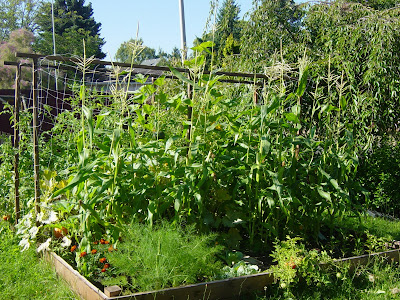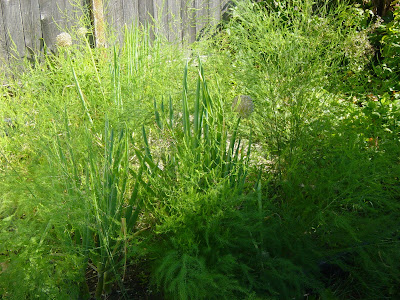Three Years Ago in April we bought our home and moved in. Before we were even fully unpacked, I bought some starter pots and seeds and started my first tomatoes since I was a child. One of the most exciting aspects to owning our own house (for me) was the chance to start a garden. When I was a child my parents had a large garden during the summer and we grew lots of fresh veggies and I learned how to start seeds, compost, plant, and weed from them. Tomato plants give off a very unique scent, that always gives me a wonderful feeling of nostalgia.
The first year, we measured out an open space between our shed and the fence and copied a friends' design. We bought some pressure treated wood from Home Depot, (about 10'x 10')
drilled screws in, and stapled strong black plastic around it. (because pressure treated wood has tons of toxins/chemicals in it). We filled it with bags and bags of soil and compost, and added stones for the kids to walk on. (BTW: This was not the cheapest way to make a garden) But, it wasn't too hard and we had a beautiful first garden that grew a surprising amount of food in about 100sqft.
The second year, we inherited some old wood and we decided to make two more beds about 5'10' each. We used brackets to hold the lengths together, and screwed the sides together. We ordered a truckload of soil-manure/compost mix and worked it into the orignial soil under the beds. This was a much cheaper alternative to making beds..finding used lumber and making what you can from it.
The older bed from the previous year became a permanent/perennial garden where I bought some strawberry and asparagus crowns. These crops will produce year after year without much more work than weeding and fertilizing. Asparagus takes 3 years for a good crop, so you have to be patient for it to reach maturity, but it will reward you with a nice early spring crop of asparagus (march-april) every year for twenty years afterwards. I also, as you may see to the right of the bed, bought some blueberry and raspberry bushes.
Year Number Three, I started to read a lot about gardening, about building the soil, making beds, companion growing. And from this reading, I recommend several really good books.
There are many more books out there, but these books give a good beginner's guide to making boxes and growing food.
The third year, we expanded some more by making two more boxes in the front yard; the best place for full sun. I was finding that my tomato plants weren't quite getting enough full sun in the backyard, and I wanted to try growing corn which also needed more sun. Our next two beds, we wanted to "look nice" because of being in the front yard. This time, we went non-toxic and invested in cedar(cedar is expensive though, but will last a long time). 2 beds 5x10. Two boards stacked, screwed into a middle thicker block in each corner. I was also reading about the advantage of growing vertically. Many vining foods such as peas, beans, cucumbers, pumpkins, squashes, even tomatoes can grow up a vertical frame. We created 4 vertical frames and nets to place on 2 of the new beds and the other 2 beds from the previous year. (this next picture I took today of this bed March 09) The one after it is from last year's peak harvest in August. 09. These frames are 5'-6' tall and 10' across with pea netting. I layed newpaper (used lasagna method) over the grass and wet down, covered with leaves, compost, left-over soil from our french drain project, and bought some manure, vermiculate, peat moss, and some extra growing soil. (building a good soil is very important because you want your veggies to have good nutrients in them)--bad, depleted soil=weak, not nutritious veggies
This next picture is of the other 2 beds with vertical frames.
And here is the 1st year bed with aspargus fronds. You just let them grow and not cut them down until they turn brown in the fall. Then you cover them up with straw.
And strawberries
And raspberries/blueberries
Below is the 4 garbage cans for potatoes and our pear tree behind them.
These past 3 Seasons, we have also composted our vegetable scraps, which in itself deserves its own blog entry as does growing each vegetable/fruit, but this entry is a survey of what we have done, and perhaps I'll go into more detail later. We use 2 earth machines.
And some smaller projects are an herb garden, rhubarb, fruit trees, and recently we moved the blueberries. (don't plant near raspberries--raspberries will bury them!!) Another hint about blueberries (they like peat moss/acid soil) I made this bed very economically out of cinder blocks we already had and the left-over soil from last years' potatoes. Behind them is a little rosemary. (sooo good on chicken and lamb!)
turned the flower box into an herb garden
rhubarb and flowers
cherry and apple trees
We also have mature pear and apricot trees, and another baby apple tree. There is so much you can do to a small-medium city lot (especially with the square foot gardening idea and growing vertically) and adding some perennials like strawberries, fruit trees, asparagus, rhubarb, etc..!
Caring for your garden: During the summer, around here, it gets really dry, so I water them every day. Some people invest in a drip method. I haven't researched this yet..perhaps I'll do that too at some point. For now, I have hoses hooked up to sprinklers, because I can't hand water it all every day with over 300 sq. ft in different parts of the yard...so I let the hoses and sprinklers do it for me. Another idea, we may try, though is to invest in rain barrels to collect water hooked up to our downspouts...This will be more laborous, but much more "sustainable" in conserving water.
Each year, I also build up the soil, add manure and compost. Plants really need nitrogen. There is so much to share and to learn...and many details add. This really only scratches the surface. I really recommend reading and finding a way that works best for you. We've tried different ways, by making the different types of beds, but recently I'm intrigued by how resourceful my next door neighbor is at finding material that does not cost too much, such as the cinderblocks and bricks, and scrapwood and her garden is absolutely gorgeous! She is very good at composting too. My compost is taking a long time to "cook"--I don't turn it often enough, not do I cut up the scraps small enough, etc..
In any case, I hope this is helpful to you starting out. I hope you get a sense that we started small and just added on each year...Even the smallest space can produce a great amount of food.
Some more books I recommend (on gardening and food)




















Good work Melinda!
ReplyDeleteGreat blog! I recommend you read Steve Solomon's Growing Vegetables West of the Cascades, and Growing Vegetables when it Counts. You need to be careful and not use too much compost here; it's too wet already! I've been using his fertilizer mix and it's really, really easy, cheap and effective. Looks like you might want deeper beds too; Steve address root systems and plant spacing in Growing Veg. When it Counts. I highly recommend a drip system, it's worth every penny and saved my garden last summer during the heat wave. Happy Gardening!
ReplyDeleteWhat a great post. I like that you explained year by year what things you did in the garden. I think starting with one bed is a great idea. It can get overwhelming if you don't.
ReplyDeleteHappy Gardening.
Thanks for commenting (I love to hear from people who read the blog!) and for the reading suggestions/and composting tip!--. I find that learning about gardening is inexaustable and there is soo much more to it than I have done so far.. (there really is a lot that is possible in a mediumish sized city lot) the latest things I've been hearing about are sheet mulching (although I think that is similar to lasagna gardening) and I'm curious to read Edible Landscaping. And learning more about the health of the soil/building that in different ways, etc.. I would LOVE to take on chickens and bees in the near future, but for now, this is what we can maintain. We don't plan to "expand" too much this year, but perhaps next year, we will. It is important to take it at a "sustainable" pace so it continues to be fun.
ReplyDelete